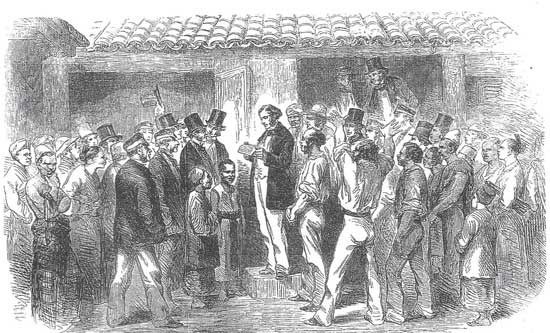Ceylon’s days of pigeon post
Pigeons are one of the fast fliers among birds, capable of notching up speeds up to 100 miles per hour. With support of winds, they can fly up to 700 miles non-stop.
Little known is that in colonial Ceylon, the Ceylon Observer newspaper which was initially based in Galle and Colombo adopted the technique of utilising carrier pigeons to transmit news. In 1850, the newspaper commenced what was a most successful service transmitting news using carrier pigeons.
The pigeons travelled sometimes twice a day between Galle which was the main mail port and Colombo, transmitting news from Indian and European sources. The birds regularly flew the 72-mile distance between Galle and Colombo within 45 minutes, at the rate of 85-90 miles an hour when in full fight.

Reading the news of the fall of Sebastopol in Ceylon: Colonel J.R. Bunker issued the following order: Headquarters -general order, Kandy, 27 October, 1855. On the instructions issued by the Governor, Sir Henry Ward, a Royal salute be fired at Colombo, this day in honour of the capture of Sebastopol by the Allied armies on the 8 September. On the day after the receipt of this order at Trincomalee, Galle, Kandy, Royal salutes will be fired at 1 p.m.
The vital news of the Crimean War (1853-1856) and the Indian Mutiny (1855) were conveyed to Ceylon, primarily by this service. The military and civil community of Colombo were in a state of anxiety over the fate of their relatives at the war front. Even the crucial news of the fall of Sebastopol on September 8, 1855 was transmitted to Colombo via the pigeons and the British Governor, Sir Henry Ward ordered a Royal Salute to be fired at once.
An engraving of this event in Colombo was published in the Illustrated London News on February 2, 1856 (see picture).
Going back in time, it was the Greeks who were among the earliest to exploit the pigeons’ ability for fast communication, using them to relay information during times of war. Results of sporting contests and the Olympic Games, were also relayed to distant cities through carrier pigeons.
During the age when Rome conquered much of Southern Europe and North Africa, pigeons flew hundreds of miles carrying important news, messages and other communications. Their special abilities were exploited to the utmost, both in the old world and the new.
The earliest known use of pigeons for messaging was recorded as far back as 1350 BC with Egyptians warning about Nile flooding that would affect their agricultural output through pigeons. The ancient Egyptians used the pigeons as military messengers as they had the ability to fly out to an identified destination.
Of the 290 known pigeon species in the world – only one has from the wild adapted to live among people in villages and cities. The feral pigeon (Columba Livia) has been domesticated by man for thousands of years. The records of the Sumerians 4500 years ago prove that they were among the first to breed these birds in their towns and villages.
Sri Lanka has at least 12 species of pigeons and doves, the majority living in the wild areas of the dry and montane zones. Only one species – the feral pigeon (Columba Livia) has established habitation in close proximity to man, and his environment.
The so-called domestic pigeon derived from the wild rock dove has an innate homing ability. Flights as long as 1100 miles have been recorded by birds in competitive homing pigeon racing. During the process of domestication pigeons were used because of their great ability to fly fast at an unerring pace and get to a destination rapidly.
Feral pigeons have a remarkable aptitude to recognise landmarks such as buildings and streets. Recent studies show that they move through man-made landscapes often flying at street level, below the height of rooftops following established routes by way of following roads and canals.
It is this remarkable, yet poorly understood ability to arrive at precisely demarcated locations that has made this species of pigeons one of the most exploited species among birds. Once in their enclosure in the pigeon loft, they are bred and the chicks’ brains get imprinted and set in their memory – usually around six weeks. Imprinting is a type of learning that occurs in the brains of birds during a sensitive period early in life. This process involves forming a strong attachment to a particular object or environment.
The outcome of such treatment during the breeding phases is that these homing pigeons will return to the same destination for the rest of their lives – in rare instances even after a lapse of several years
In India, pigeons were used extensively for centuries and in the late 18th century, the Mysore-based ruler Tippu Sultan (1750-1799) also used them to spy on the troop movements of the English forces stationed in Chennai and about to launch an attack on his territory during the Fourth Anglo-Mysore War in 1799. That ended with the capture of the capital Seringapatam.
The pigeons who were well cared for by a special team of pigeon trainers returned to the neighbourhood of the Jamia Masjid mosque (main masque) in Seringapatam where there were eight storeyed multi-lofts for them. By the mid-18th century the rearing of pigeons for sports, competitions, races and circuses was at its height.
But it was both in America and Europe that these birds were used strictly for military purposes. The whole training of pigeons was brought to a sophisticated level in World War II.
Legendary is the account of how the first news of the D-Day landing on the beaches of Normandy in France on June 6,1944, was brought to Britain by a pigeon named Gustav. Reuter correspondent Montague Taylor who was on board the landing ship heading towards the beaches, relayed the message which was carried back to England by Gustav. Since ships had to maintain radio silence, Gustav flew 150 miles to convey the momentous news. The bird returned safely to its loft in at Thorney Island in five hours and 16 minutes.
Special care was taken in organising the message to the size of a quill, hanging down and then connected by a soft twine wound around the pigeon’s leg, and positioned just above the claw. When flying the bird draws up the leg under the cover of the wing so the damage to the article is minimal and it is well protected.
The pigeons’ eyesight is far keener that ours and they can see further and with greater clarity than we can.
The only other birds that can match these feats are the Spine-tailed Swift and Peregrine falcons. The Spine-tailed Swift also known as the White-throated Needletail is said to fly at a top speed of 105 miles an hour – the fastest recorded on a level flight and in a straight line.
Searching for an ideal partner? Find your soul mate on Hitad.lk, Sri Lanka's favourite marriage proposals page. With Hitad.lk matrimonial advertisements you have access to thousands of ads from potential suitors who are looking for someone just like you.


